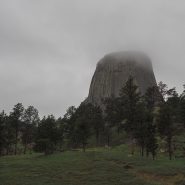Posted by Jeff on Sep 10, 2019 @ 6:53 am in Conservation | 0 comments | Last modified: September 9, 2019
Some of the places most sought after by recreationists are also culturally, spiritually, and/or economically vital to Native American tribes. As more people take to these lands to hike, bike, climb, ski, paddle, or camp, respect for indigenous values sometimes fades.
In Wyoming’s Devils Tower National Monument, for instance, an increasing number of climbers are choosing to ignore a voluntary June climbing ban that’s been in place for more than 20 years to allow local tribes to hold ceremonies at the site. Roughly 373 climbers scaled Devils Tower in June 2017, compared to 167 in 1995.
Some sacred places are strictly off-limits to non-indigenous folks. But more often, Native Americans are happy to share their traditional homelands if recreationists respect the cultural heritage of the places we want to play.
The Oglala Lakota were granted Devils Tower through an 1851 treaty, and the U.S. later violated that treaty, forcing the tribe onto a reservation. Honoring the June ban and other tribal requests is a small way to acknowledge Native people’s past, and honor their modern rights.
The following are paid links. As an Amazon Associate I earn from qualifying purchases.
 I am Jeff Clark, founder of Internet Brothers, producer of this blog, and passionate about hiking. I live in Western NC near the Blue Ridge and Great Smoky Mountains. Pisgah and Nantahala National Forests are just out my door, so the content will focus on these areas, but let me know what you would like to see on the site.
I am Jeff Clark, founder of Internet Brothers, producer of this blog, and passionate about hiking. I live in Western NC near the Blue Ridge and Great Smoky Mountains. Pisgah and Nantahala National Forests are just out my door, so the content will focus on these areas, but let me know what you would like to see on the site. 
Copyright © 2011-2023 Internet Brothers. All Rights Reserved. ISSN 2324-6057
Designed by Elegant Themes | Powered by Wordpress | Logo by Design Aspirations

